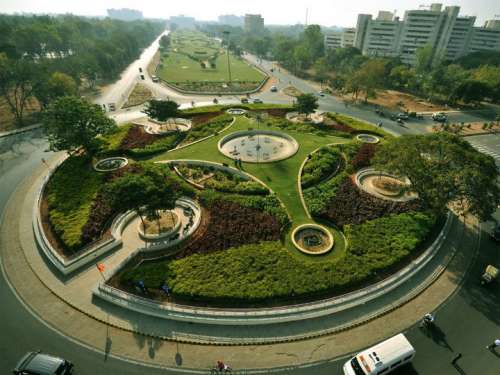Prelude
In the 13th century, King Pethasinh of Pethapur, ruled over Shertha town. After the death of Pethasinh, the Sultanate of Patan used this land as battle ground. Sultan Ahmed Shah decided to move his capital from Patan to a new city, and built Ahmedabad. In 1960, Bombay state was split in two different states, Gujarat and Maharashtra. Ahmedabad became capital of Gujarat, and a new capital city was to be built on land which was once part of Pethapur state.
Panorama of Gujarat Legislative Assembly at Sector 10
The new capital city was planned by Chief Architect H.K. Mewada, educated at Cornell University, and his assistant Prakash M Apte.Both Mewada, and Apte had worked as trainees under legendary architect Le Corbusier in the Chandigarh Project in the 1950s. Gandhinagar's streets are numbered, and have cross streets named for letters of the Gujarati alphabet (e.g., "k", "kh", "g", "gh", "ch", "chh", "j"). All streets cross every kilometre, and at every crossing traffic circles decrease the speed of traffic.
The city has developed in four distinct phases:
Phase 1: After the city's infrastructure was completed in 1970, and until 1980, it was known as 'Gandhian City,' since it was based on Gandhi's concepts and principles. Phase 2: Between 1980 and 1990, a time of low pollution, it was known as 'Unpolluted City'. Phase 3: After 1990, many trees were planted, and the city became the 'Green City.' Phase 4: In 2002, Gujarat's Chief Minister, Narendra Modi, proposed a new, triple focus for the city: it should be green, It should use solar energy, and It should be cosmopolitan. The new city is linked with Ahmedabad on the south by a direct road, having a straight alignment and a right of way 91.44 metres (300.0 ft) wide between the proposed capital and the railway station of Khodiar about ten kilometres (six miles) to the west.
This road was proposed to be extended further to the south to join the State Highway at Surkhej near Ahmedabad. A road over bridge was to be provided at the crossing of this road and the Ahmedabad Delhi metre gauge line at Khodiar. Thus, traffic from Saurashtra area could directly come to Gandhinagar without going through Ahmedabad. The road link to Khodiar also connects the new city with Ahmedabad-Mount Abu State Highway. The site is connected to National Highway No, 8 (Bombay-Delhi) across the river by 5 km (3.1 mi) link road.
The alignment of the proposed extension of the broad-gauge railway from Sabarmati to the Fertiliser Complex at Saij near Kalol and also to the thermal power station installed in the industrial area in Gandhinagar, was to run along the western boundary of the township. It was proposed to have a railway station in the centre along the western boundary of the township. The railway line was to run under proposed road over bridge at Khodiar and where it crosses the Ahmedabad-Kalol State Highway, there was to be a road over bridge. The new city was thus very well linked by road, rail and air with.all parts of the state and the country.

Akshardham
Swaminarayan Akshardham in Gandhinagar, Gujarat is a large Hindu temple complex inspired by Pramukh Swami, the current spiritual head of BAPS Swaminarayan Sanstha. Located in the capital of Gujarat, the complex was built over 13 years and is a tribute to Swaminarayan and his life and teachings. At the center of the 23-acre complex is the Akshardham mandir, which is built from 6,000 metric tons of pink sandstone from Rajasthan. The complex’s name refers to the divine abode of Swaminarayan in the BAPS philosophy; followers of Swaminarayan believe that the jiva or soul goes to Akshardham after attaining moksha, or liberation. BAPS followers worship Swaminarayan as God almighty.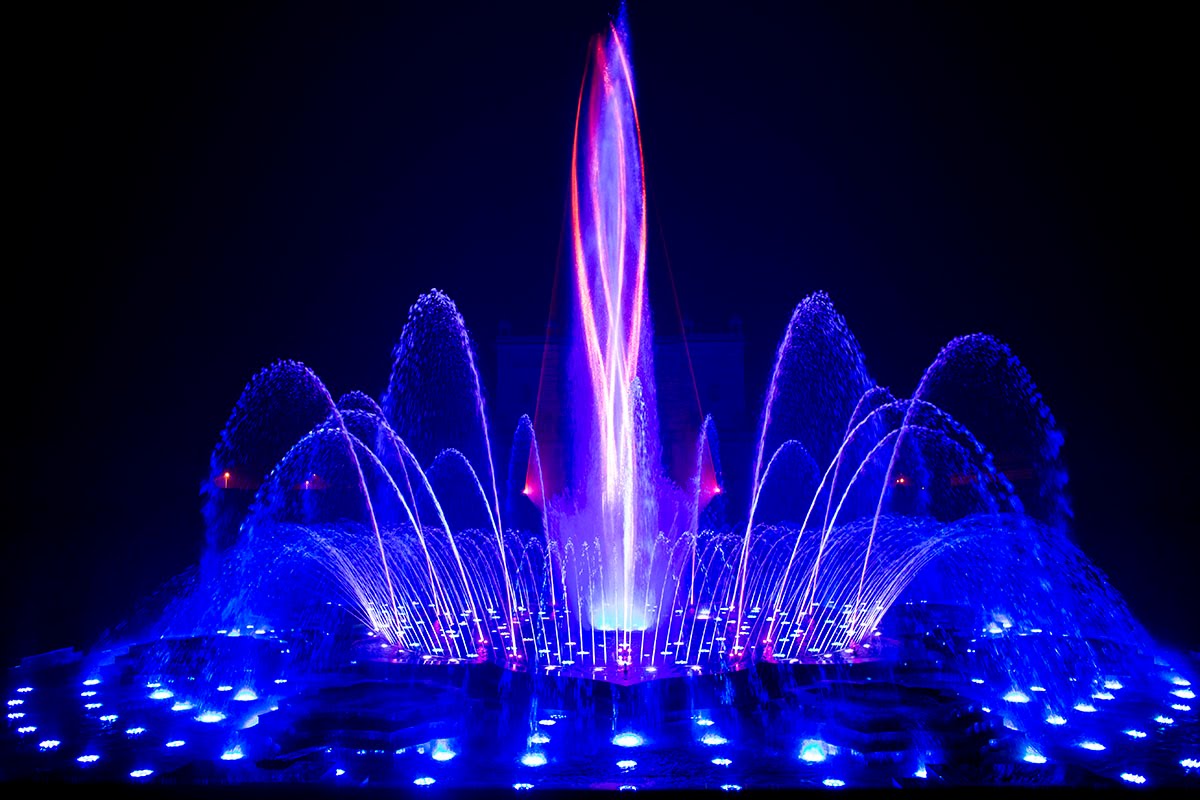
Sat-Chit-Anand Water Show
The Sat-Chit-Anand Water Show is an interpretative performance of the parable of Nachiketa, as told in the Kathopanishad. The show’s title translates to Truth-Knowledge-Bliss and is an appellation of the Hindu ontological reality Aksharbrahma or Akshardham. The show was inaugurated on 3 April 2010 by Pramukh Swami. The vibrant show employs fire, fountain animations, laser, water screen projections, music and live characters in a 45-minute retelling of Nachiketa’s choice. Nachiketa was the son of a rishi named Udalak, who organized a yagna in which he gifted sickly, barren cattle to Brahmin attendees.Nachiketa was troubled by his father’s deception and asked to whom he himself would be offered to in charity. Angered by this question, Udalak banished Nachiketa to the realm of Yamapuri, the underworld. Nachiketa stood at King Yama’s doorstep for three days waiting for Yama’s arrival; Yama was impressed by Nachiketa’s resoluteness, and offered him three boons. Firstly, Nachiketa requested that his father may welcome him lovingly upon his return home; next that he be granted the knowledge by which he can be worthy of living in the heavens; and lastly he may attain knowledge of the eternal soul, the Atma, which transcends death.The story of Nachiketa offers lessons in realizing one’s true Self, living by one’s principles, perseverance in the face of difficulties, and keeping spiritual perspective in any circumstance.Adalaj Step-Well
The Adalaj step-well is a popular tourist attraction of the city and is situated 18 km. south of Gandhinagar. The well was built in 1499 A.D. by Queen Rudabai. The step well or Vav, as it is called in Gujarati, is intricately carved and is several stories in depth. The designs on its walls and pillars include, leaves, flowers, birds, fish and other breathtaking ornamental designs. In the past, these step wells were frequented by travellers and caravans as stopovers along trade routes. There is an opening in the ceilings above the landing which allows the light and air to enter the octagonal well. However, direct sunlight does not touch the flight of steps or landings except for a brief period at noon. Hence some researchers say that the atmosphere inside the well is six degrees cooler than the outside. Another remarkable feature of this stepwell is that out of the many stepwells in Gujarat, it is the only one with three entrance stairs. All three stairs meet at the first storey, underground in a huge square platform, which has an octagonal opening on top. The vav is a spectacular example of Indo-Islamic architecture and design.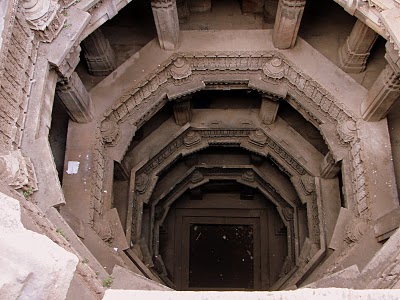
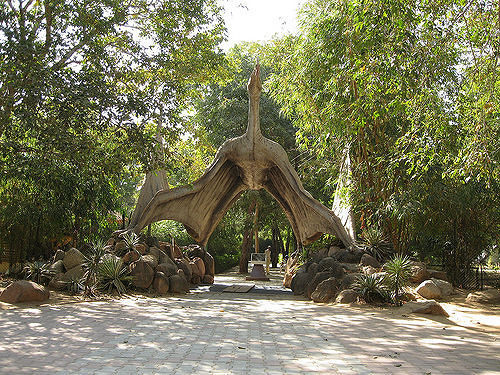
Indroda Dinosaur and Fossil Park
The Indroda Dinosaur and Fossil Park in the Gandhinagar in the state of Gujarat, India, has been described as the second largest hatchery of dinosaur eggs in the world. The Park was set up by the Geological Survey of India and is the only dinosaur museum in the country. The Park is run by the Gujarat Ecological and Research Foundation (GEERI) and is regarded as India’s Jurassic Park. Several fossilised dinosaur eggs and skeletal parts have been found here. The fossils which were found in Upper Cretaceous formations in the region date back 65 million years ago. The eggs are of different sizes, some the size of cannon balls. Fossil trackways of these gargantuan animals are also on display in the parkTrimandir
A gorgeous non-sectarian trimandir inspired by Akram Vignani Pujya Dada Bhagwan has taken shape at Adalaj on the outskirts of Gandhinagar. The followers of Pujya Dada Bhagwan from all over the world gathered to celebrate the Pranpratistha from 25th to29th December 2002. The central sanctum of the temple has a 13 feet high idol of Shri Simandhar Swami weighing 18 tones. The idol of His shaashan dev Shri Chandrayan Yaksh and devi Shri Panchanguli Yakshini are also placed. It also houses the idols of Shri RushabhDev Bhagwan, Shri Ajitnath Bhagwan , Shri Parshwanath Bhagwan and Shri Mahaveer Bhagwan, Shri Chakreshwari Devi and Shri Padmavati Devi. The first sanctum of the trimandir includes the Shivling, Parvati Devi, Hanumanji and Ganpatiji whereas the third temple includes Shri Yogeshwar Krishna Bhagwan, Tirupati Balaji Shri Shrinathji, Shri Bhadrakali Mataji and Shri Amba Mataji.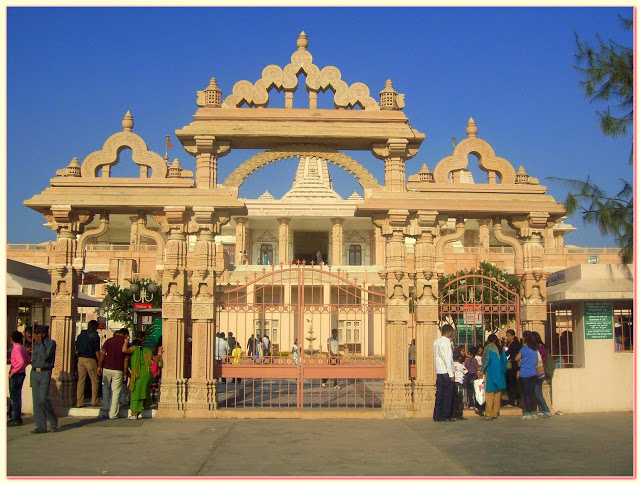
Capital complex and government offices
The Capital Complex, consisting of the Secretariat, the Legislative Assembly, the High Court and Offices of Heads of Departments is located centrally in one sector with an area of 75 hectares (190 acres). It has been so planned as to merge gradually with the river front landscape to the south-east.
The Capital Complex is placed on the south-east end of the central axis road no. 4 which is planned as an avenue having a central green of about 60 metres (200 ft) width. In the planned expansion of the city it was proposed to extend the city towards North-West and extend the road no. 4, so that the capitol complex would remain the focal point of the central avenue of the capital city. Behind the Capitol Complex on the river front was the designated location of an imposing memorial to Mahatma Gandhi either as a tall statue or a symbolic representation of his ideals.
Other offices of the state government have been located to the north of the Capital Complex while to the south, the area is reserved for offices of the Government of India. The entire Government Office Complex covers an area of about 150 hectares (370 acres). The area is located so as to be within easy reach of the residences of most of the government employees.
